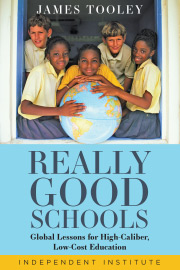PISA Results Show We’re a World Leader . . . in Spending, Not Performance
Spending more and getting less—it’s an increasingly common refrain in education circles these days. Even U.S. Secretary of Education Arne Duncan called the performance of American 15-year-old students, who slipped in the latest international reading, math, and science rankings, a portrait of stagnation.
Every three years since 2000 the Organization for Economic Cooperation and Development (OECD) administers the Program for International Student Assessment (PISA). More than 500,000 students from in 65 countries and economies participated in the 2012 assessment. Key findings released last week for the United States include:
- Among the 34 OECD countries, the United States performed below average in mathematics in 2012 …and around average in reading and science.
- There has been no significant change in these performances over time.
- The U.S. spends more per student over the course of their elementary and secondary school years than most countries but does not perform better: the Slovak Republic, which spends around $53,000 per student , performs at the same level as the United States, which spends over $115,000 per student.
- American students do not report strong motivation towards learning mathematics: only 50 percent of students agreed that they are interested in learning mathematics, slightly below the OECD average of 53 percent.
American students’ PISA performance has been flat for more than a decade—essentially average in reading and science, but below par in math. Education Secretary Duncan summed up by saying:
The big picture of U.S. performance on the 2012 PISA is straightforward and stark: It is a picture of educational stagnation. That brutal truth, that urgent reality, must serve as a wake-up call against educational complacency and low expectations. …The hard truth is that the U.S. is not among the top performing OECD nations in any subject tested by PISA—and that is the case even though U.S. students express more self-confidence in their academic skills than students in virtually all OECD nations.
Who has caught up to or surpassed us since 2009? In math, students in countries such as Ireland, Poland, Latvia, the United Kingdom, and the Czech Republic now outperform their U.S. peers. In science, Poland, Ireland, and the Czech Republic are now ahead of us. And students in Lithuania, Italy, and Spain are now on a par with U.S. students. In reading, our strongest subject, our 15-year-olds are now behind those from Estonia, Poland, Ireland, Germany, and the Netherlands.
Out of the 62 education systems that administered the PISA in both 2009 and 2012, our ranking fell from 24th in 2009 to 29th in math in 2012, according to OECD’s figures. In science, we fell from 19th to 22nd. And in reading, our ranking dropped even more sharply—from 10th to 20th.
National Education Association President Dennis Van Roekel blames student poverty for such poor performance. In other words, until all kids are rich, don’t expect them to perform in school.
Too bad the OECD already analyzed the correlation between poverty and performance and found that a student’s socioeconomic background explains only 15 percent of test score variances. Jack Buckley, the commissioner of the National Center for Education Statistics, also noted that upper income American students did not perform as well as their peers in other countries.
Duncan elaborated, noting that American white students lag behind several countries, including Vietnam, where 79 percent of students come from poverty. “So the real educational challenge in America is not just about poor kids in poor neighborhoods,” Duncan concluded, “It’s about many kids in many neighborhoods. The PISA results underscore that educational shortcomings in the U.S. are not just the problems of other people’s children.”
But more expensive failing programs from the U.S. Department of Education are the last thing we need—especially since research shows a strong correlation between PISA mathematics improvement and economic growth.
And why do students in some countries outperform others? Other rigorous research has found that competition from private schools, high-quality standardized testing, school autonomy over hiring and firing of teachers as well as setting salaries, and minimal influence by teachers unions on curricula all contribute to higher PISA math scores. Were all these factors in place, students could score 200 points higher on PISA math, which would put American students well above top-performing Shanghai—not squarely in the middle or back of the pack where they are now.













